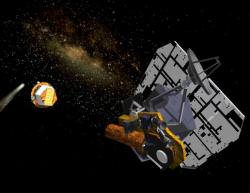NASA’s Deep Impact completed its main mission. Back in July 2005, the spacecraft’s impactor carved a hole great big hole out of Comet Tempel 1, helping scientists study what lies beneath its surface. But now its time for the spacecraft to re-enter the space workforce and help discover alien worlds.
NASA recently announced that they had extended Deep Impact’s mission to fly past another comet. This time it’ll be Comet Hartley 2 on October 11, 2010. Just like the previous mission, Deep Impact – now renamed EPOXI – will be studying the surface of the comet with its suite of scientific instruments.
But between now and then, the spacecraft has some time to kill. So astronomers searching for extrasolar planets are calling it into service.
The spacecraft will be focusing its largest telescope at five stars, hoping to catch a glimpse of a planetary transit. This is where a planet dims the light from its parent star as it passes in front.
EPOXI Deputy Principal Investigator Dr. Drake Deming of NASA’s Goddard Space Flight Center in Greenbelt, Md explains the technique:
“When the planet appears next to its star, your telescope captures their combined light. When the planet passes behind its star, your telescope only sees light from the star. By subtracting light from just the star from the combined light, you are left with light from the planet,” said Deming, who is leading the search for exosolar worlds with Deep Impact. “We can analyze this light to discover what the atmospheres of these planets are like.”
This search for extrasolar planets has already begun. Deming and his team directed EPOXI to begin making observations on January 22, 2008. It’s looking at stars which are already known to have transiting planets. The hope is that these stars actually contain multiple planets. Since planets seem to orbit on the same plane, if one passes in front of the star, the rest should too. Even if the planets don’t pass perfectly in front of the star, the spacecraft might be able to detect them from the gravitational influence they have on light coming from the star.
EPOXI will be looking for transiting planets down to the size of Earth, orbiting some of our closest neighboring stars.
Original Source: NASA News Release


EXCITING!
Continue the success for beyond.
Is exciting. Foundation for future and beyond.
i doubt whether a planet the size of eart will be able to dim the light of its parent star enough to be located
I LOVE it when these probes do double duty!!! Go Mars rovers!
Always equip probes with more than they’re asked to do! Space has so much to look at. I hope this one finds some great new news!
Ironically, it’s a flaw in the telescope that allows DI to carry out this mission. The ‘scope is slightly out of focus, spreading light from a star across multiple detectors.
Actually an Earth-sized planet transiting a solar-type star has an amplitude of something like 90 micromagnitudes.
I thank you for the information you really give us on this website and what really impresses me much is the alien life and discoveries.Anyway keep it up.
phillip from Rwanda…
BTW, it would be nice if any anyone finally constructed kind of more universal spacecraft so that it could orbit planets, hunt comets and freely move across the interplanetary space and make tasks that are currently transmitted from Earth.
But with the fiscal troubles of space agencies and the fact the budget is usually approved on the projects-based principles, it is perhaps sound of far future :-/